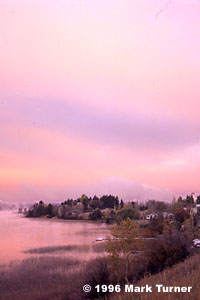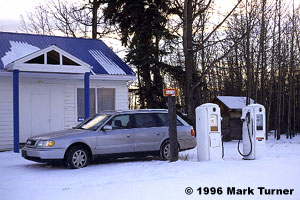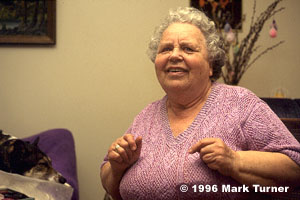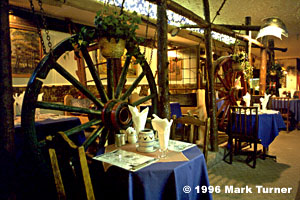Day 2: October 20
100 Mile House to Dawson Creek, BC
by Rich Truesdell & Mark Turner

We left 100 Mile House with Rich at the wheel shortly after 7 am today and drove north to Lac la Hache where the mist was rising from the water into the frosty morning air as the sun was just beginning to peak over the low hills to the southeast. In the northern sky the clouds turned a rosy pink over the lake. We pulled off the highway for a quick photo session before the color in the sky faded to a pale yellow. Lac Lla Hache is one of the longest natural lakes in British Columbia and we followed its shoreline for many miles.
We arrived in Williams Lake around 9 am and stopped at Denny’s for a cheap and filling breakfast. It appeared to be the popular place to eat on Sunday morning before church as all the tables were constantly filled. We continued north with Rich still at the wheel, passing through the tiny villages of Soda Creek, Marguerite, and Kersley without hardly noting them. Quesnel was the next town of any size, and there we crossed the Fraser River again. The old wagon road from Lillooet ended in Quesnel where the miners continued their northward journey by steamboat.
Rich noted that the car handled exceptionally, and that the seating position is excellent. 200 miles of hard driving proved no problem. Noticed that with the sunlight low in the morning, that the texture of the dash materials cast a glare onto the instruments which was somewhat of a problem.
This is gently rolling timber country for the most part, punctuated by broad agricultural valleys. We traveled under generally gray skies after the beautiful morning light at Lac la Hache. The hues along the side of the road were predominately shades of brown — huge round bales of hay left in the fields, dry grasses along the roadside, and bare tree trunks contrasting with the predominant coniferous forest. Clear-cut logging was in evidence along much of the route.
Handed off to Mark at Prince George after stopping to get a plug for the Sony MiniDisk player at Radio Shack. The store was in mall much like any in North America, but on a slightly smaller scale. As soon as I handed off to Mark, the weather turned as s now had fallen earlier and started to fall within 20 miles north of PG. I took some time to explain the principles of ABS, which was new to him.
Thus far I am struck by the natural beauty of the road traveled but surprised by the lack of fall colors, remembering falls from growing up in the NE. Mark is quite knowledgeable of all the different types of vegetation. He explained that most of the trees are evergreens,primarily lodgepole pine, which goes a long way to explain the situation. The sorest also contains some aspen, but by the time we passed Williams Lake they had all dropped their leaves for the winter. I would imagine that in a suitable open car, this would be an exhilarating trip just after Labor Day when most of the tourist/sportsman traffic has gone on to other pursuits.
The level of services along the route thus far has been greater than expected from reading the Milepost. It seems that unless one advertises in the MP, the establishment will not be mentioned in the text. Seems fair enough, but the traveler needs to know that the best reference for planning a trip along the route is incomplete and not comprehensive.
For a family man used to a Plymouth Voyager, Mark seems to have adjusted easily to the advantages offered by the AWD equipped A6. Although the posted limit is 90 kph, MT has had no difficulty in gravitating to 120-130 kph, even when road conditions might have dictated otherwise. The car inspires confidence, even from someone who is not a car enthusiast per se.

From Prince George north the communities became fewer and farther between. We left the Fraser for the last time, but continued to see small lakes along the road, their edges beginning to freeze over for the winter. We passed Summit Lake, Bear Lake, and McLeod Lake, all names for both bodies of water and tiny communities. After passing the turn-off to MacKenzie the road began climbing up over Pine Pass, about 4000 feet elevation and our first real experience driving the Audi on snow. After the pass the road descends into the Peace River valley at Chetwynd, a logging and minerals-based community which also bills itself as the chainsaw sculpture capital of the world. We didn’t stop as the skies continued gray and the light dull and uninteresting.
About 50 km SW of Dawson Creek, near the Groundbirch community, we spotted what appeared to be an abandoned pair of gas pumps fronting a tidy white home. Being a collector of petrolania, I decided that it was worth a second glance, Mark sensed a photo op. We were photographing our A6 from behind the 50s style pumps when we noticed an elderly woman peeking out from a curtain in one of the front windows. She motioned for us to come inside for coffee.

For more than two hours Erna Blask told us her life story, from her emigration with her husband from East Prussia following WW II through their establishing a gas station along Route 97 in 1959, when it was being transformed from a trail to a gravel road. First serving as a dealer for Royalite, a now defunct Canadian Petroleum distributor through a 21 year affiliation with Imperial (ESSO), she described how life has changed over the years. At one time she was one of only two women owning and operating an ESSO facility in all ofBC.
In Dawson Creek, on Sunday night, we stayed at the Alaska Hotel and dined there as well. As the sign on the front says, it is 55 paces from Mile 0 of the Alaska Highway. We were welcomed by Chris Kux-Kardos and Emanual, her fiancee from Portugal. The Alaska Hotel, originally known as the Dew Drop Inn, has been a fixture on the Dawson Creek scene since 1930 when it was known as the Dew Drop Inn. By the time the Alaskan Highway was finished in 1943, the original 6 rooms were expanded to 35.
In 1972, Charles and Heidi Kux-Kardos, emigrating from Hungary, bought the adjacent Alaska Cafe for a grand total of $308. In 1989, they purchased both the Cafe and the hotel from its previous owner.

Although it had been reported to us that the Alaska Hotel was somewhat rundown, such was not the case. Rather than a cookie cutter, by-the-interstate overnight facility, the Alaska featured small, clean rooms, furnished with a variety of antiques from the Kux-Kardos collection. It was much more like staying in a bed and breakfast than a hotel, even if no breakfast was served.
It should be noted that the Cafe is listed in ”Where to Eat” in Canada, listing the 500 best restaurants in Canada. After a satisfying dinner, and consuming the first of what to be any prime ribs to be consumed in this expedition, we sat down and talked with our hosts. This would become a practice that both Mark and I want to follow in the weeks ahead. As Chris and Emanuel recently became Internet junkies, Mark and I spent more than an hour showing them the ropes as well as giving them a number of bookmarks to our pages as well as other cool sites on the Web.

